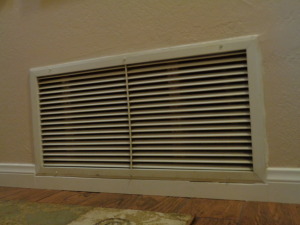Common Scenario: On a cold, winter night, you decide to have a warm, cozy fire in your open fireplace to take the chill out of the living room. Your house is still cold and your furnace turns on automatically. A short time later, you notice the air in the room is getting smoky. All of a sudden, that nice cozy fire isn’t so nice and you know you’re going to be smelling smoke for days.
A fireplace smoking problem is a common occurrence. Ethical chimney sweeps will always suggest the simplest and most cost-effective solution to a smoking problem. One of the most common and very easy-to-fix causes is “dueling furnaces and fireplaces,” competing for the same finite amount of air in a house. This is especially true in a relatively new home or a home with new windows where the home is “tight” and energy efficient.
Tight houses don’t make for good fires in open fireplaces.
Competition for Air
Tight weatherstripping on doors, double-pane windows, sealed vapor barriers and upgraded insulation in walls and attics make for a well-sealed house, creating a house with a finite amount of oxygen.

A fire in an open fireplace requires a great deal of oxygen. It draws a huge amount of air from the living area and draws it up the chimney. This is a natural draft system. Whereas, the air intake grill for a furnace pulls massive amounts of air from the home into the furnace. This is a mechanical draft system.
If an open fireplace (with a natural draft) is close to the air intake grill for a furnace (which uses a much stronger mechanical draft), the furnace will always win because the draw for the furnace is stronger than the draw for the fireplace. Mechanical is stronger than natural.
This means that you’ll lose the draft (upwards motion of the air in the fireplace flue), resulting in drawing the smoke into the room.
The closer the open fireplace is to the furnace air intake grill as well as the tighter the house, the more likely you can experience a smoking problem when the furnace and fireplace are on at the same time.
This is especially important to know when you have artificial gas logs in your fireplace because those gases going up the flue are colorless and odorless. If the furnace is on at the same time, you won’t know if those gases from the fireplace are being pulled into the room instead of going up the chimney flue.
Other systems in your home can also have this same reversing effect on the fireplace, such as: Whole house fans, kitchen stove hoods, bathroom fans, clothes dryers and central vacuums. These systems draw air from the house and exhaust to the outside.
Slightly opening a window close to the fireplace may help in this case. This will provide the necessary make-up air that a fire needs to provide for a good draw.
For other potential causes of smoking problems, check out our blog post on the Top 10 smoking problems and their respective solutions. To find an ethical and reputable C.S.I.A Certified Chimney Sweep, go to the Chimney Institute of America website.
Rule of Thumb
Avoid having the forced air heater or furnace turned on at the same time as an open fireplace and get back to enjoying that cozy fire!


